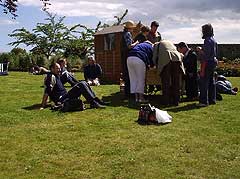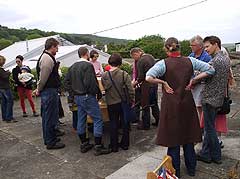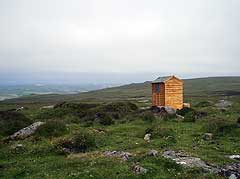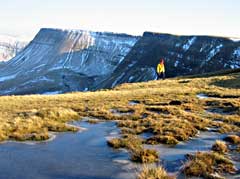ELI EVENTS 2005
The National Botanic Gardens of Wales, Carmarthenshire: Monday 30th May 2005
The
gardens scheduled a Festival of Herbs and invited us to take part. We
undertook three walks & events during the day and presented video and sound
material in an installed garden shed and within the Physicians of Myddfai
hall.
Each event consisted of a walk, collecting herbs and discussing Botanic properties. The structure of the walk and search for herbs on the wild flower meadow facilitated an informal exchange of family remedies, and stories. The making of ointment took place within the field using mobile ointment making equipment constructed specifically for the project. The kit created a perfomative space and focus that enabled us to find appropriate sites to begin the making process in the field. Stefhan microphoned the cooking equipment to amplify the cooking and stirring process.
On return to the Eli shed participants created a map of the experience on pre-printed map pro-formas and left with ointment, labelled with herbs, time and place. The ointment literally and metaphorically contained the essence of the site and experience, became a map itself, applied to the skin.
During the day approximately 80 + people participated in the events, many more encountered the shed (some wanted to buy it!) and engaged with the recorded material and talked to the artists. Many people were then referred to Gareth Evans, a researcher at the gardens concerned with folk herbal in Wales; some of these people are now taking part in his research.
It was a hot bank holiday weekend and the gardens were very busy. Initially unsure of the context and how our presence was to be perceived, as the day went on we relaxed into the event.
Llandudoch (St Dogmaels, Pembrokeshire): Saturday 4th June 2005
In Llandudoch we followed a similar structure to the first event. The
differences were governed by the space and history of the site. St.Dogmael
was a contemporary of Dewi Sant and was considered a bone healer. The old
school made a great space to present the artefacts and video material. Again
a very diverse group of people attended ranging from the ages of 6 - 75.
Approximately 50 people attended the two events.
There was a very enthusiastic process of gathering and making initiated by the large number of children attending the morning event, in contrast in the evening adults handled materials, engaged in a more reflective way with the process and different forms of mediation.
On reflection we needed to have publicised this event more within the village itself, in order to reach more residents.
Bedd Morris, Preselli Hills, near Trefdraeth/Newport, Pembrokeshire: Saturday 11 June.
The site and the day proved to be the most charged and poetic out of the
three events. We sited the Eli shed on the mountain, carrying each piece and
constructing the shed that morning, installing the sound and video material
powered by battery and a 12v converter.
Approximately 55 people arrived, and splitting into 3 groups we walked onto the mountain to gather 3 different herbs; tormentil, bedstraw and daisies, all with properties to heal wounds and bruising. The groups eventually arrived at the Eli shed with a handful of herbs each (having 'grazed' the moor) and made ointment and maps, sharing stories on the mountain on a special sunny evening. A process of applying the left over ointment to peopleÕs hands began and eventually everyone walked home with the plants of the place and memory of the walks on the skin.
We felt a sense that we had arrived at a strong collective structure and created an evocative event on Preseli .
Artists comments
Maura Hazelden
From my viewpoint as an artist and an amateur botanists I learnt the
academic skills of picking apart modern myth dressed as ancient and a bundle
of Latin, Welsh and German plant names.
There was always one more plant to become significant: on the last night before the last event I was researching veronica officinalis, just found on Carningli, finding that it was significant in Wales and has the word physician in its Welsh name; also I was shown a local book containing information about this plant commonly known as heath or common speedwell during the next day.
Walks and places were remembered and mapped by a trail of plants, useful or otherwise; plants were remembered by their position in the land.
Small parts of west Wales and Darmstadt sit in my fridge to take me on walks in rain, on ice, under sun, through trees, amongst ticks and retell stories from ancient and modern herbalists, botanists and people that I met along the way.
Peter Bodenham
Reflecting on the project I found the process of making objects which
'perform' creatively fulfilling. The process of making the medicinal boxes
and wheelbarrow / workstation reinforced my interest in the making objects
that literally and metaphorically contain elements of the project. I
encountered fascinating stories, tapping into the undertow of family stories
and remedies from the village and beyond, This included uncovering
inadvertently one particular family incident concerning their tad-cu, a
local herbalist. An awareness of secret knowledge within a family or
community signifies belonging / exclusion, being on the inside or the
outside.
Simon Whitehead
My process of engagement with the project began in June 2004 with a
conversation with neighbour Ieuan Jones over the garden hedge in Penrhiw,
Abercych. Ieuan was born and grew up in this house and has a detailed and
embodied relationship with the place, people and the rhythm of plants that
grow here. Our conversation continued around the old apple trees in our
gardens and the revelation that one of our trees was grafted onto with a
branch from his oldest apple tree around 30 years ago and now produces
fruit. Ieuan told his own history of these trees and I decided that the
first ointment I would make would be from the apple tree blossom growing
over in each others gardens, The ointment was made under the tree and a pot
given to Ieuan.
Recordings of our conversations were then used as the basis of a sound piece composed by Stefhan Caddick, which was to accompany a video projection I made of 22 hands of people living in our communities, the names of herbs found and places visited written upon them. Both these pieces were installed in a garden shed for the events.
The seasonal visits to Llyn y Fan Fach were to become a particular ritualised anchor to our process. Ointments made on the banks of the lake from available herbs, that were searched for, identified and picked resulted in a kind of homage to myths of this site and its place within the history of Welsh medicine.
At the Botanic gardens a retired teacher offered to tell an assembled group the story of the lady of Llyn y Fan Fach whilst we made ointment. She became an important part of the event.
An elderly lady from Graig y Nos, whose father was a miner and the village herbalist, told of a life using herbs from fields and garden to heal her ailments, of an archive of remedies her father had written. The project became a bridge here to bring her into contact with Botanic researcher Gareth Evans and their conversation continues.
ELI for me was also so much about the body, the direct relationship to land and what grows nearby. The journey to find, gather, make and the application of medicinal maps to the skin was a simple and effective metaphor to bring people back into contact with what is possible in their locality. Perhaps our work can be this; a conduit to engagement through the body, its sensory life, and a reconstitution of disappearing knowledge.
Stirling Steward
I have been most interested in the 'ordinary'/'common' - the plants &
flowers which grow nearby & we recognise even if we don't know their names
or properties. Gaining & sharing some basic knowledge of these is powerful -
it cultivates relationship both to creativity & to health, weaving them
together. It's not complicated.
At Bedd Morris I lead the group collecting daisies - many of those who chose to join me were children & their enthusiasm as they ran the moor was infectious - we crouched to gather & identify (finding frogs as well as flowers!) & I was struck by their physicality & curiosity. For them there are no dividing lines between art & science, they are engaged in both, engaged essentially & directly in the world around them. Hopefully this is the way to encourage them to care enough, to understand instinctually, that we are part of a larger whole.
Talking to Mrs. Davies in the cook shop in Cardigan, she tells me of her mother's use of herbs - the stories as she remembers them are fragmented, what I am most interested in is the spark which seems to come to her eyes as she talks. This, like the passing of recipes through a family, creates tangible links in time & knowledge - not based upon official documentation but upon one person's passion and experience & the way they communicate it. The risk is that this oral tradition & it's active, empowered use may disappear. For me the Eli project has illuminated the need to continue to communicate in a way that can truly facilitate sharing about what matters.
I edited together a video document of some moments along the way - it seeks to be sensual & provide glimpses of the process we followed.
Audience comments
Gareth Evans, Neath (Botanic Researcher and writer)
Making ointment is an experience I have done before. OintmentÕs (the group) extended and contemplative take on this task made this different. It lead me into the landscape by a new route. It was good being allowed into the landscape in focussed way without the distraction of imperatives, such as even walking to a certain point at a certain time. However the structure of ointment-making, bottling and labelling like some ritual set up an atmosphere where people talked with some freedom.
I had a serious conversation with one man on medicine in Wales, artefacts in the Welsh landscape and poetry. Another talked about her father who had been a healer or "herbman" for his village. He had been a miner but the strength of his medical knowledge had gained the respect and even the friendship of the local doctor. Although he moved away towards the end of his life, he is still remembered in his village, Coelbren. I found this interesting as I knew the area. He would follow the path away from the mining area of open cast mines and washeries, and into the flower-rich limestone country of the Brecon Beacons where he would gather ingredients to take back to make the medicines. Towards the end of his life he offered his books to Swansea University, who took them away with a van.
John Sharkey, Mynachlogddu, Pembrokeshire
'The manner in which the artists highlighted their quiet shift from exhibiting in urban galleries to more interactive art, challenged both their own ideas as well as local perceptions of media, video and performance work not usually available in this farming community...In a very visible manner, the essence of what everyone collected was gifted as a small pot of ointment, from the artists, to each of us our own mapping of the plants, places, process and participation. A tactile and aromatic memory'.
Julian Ruddock, Aberystwyth
'A really enjoyable experience which stayed with me for some time afterwards. Most affecting for me was returning to the school and sitting down on the floor with the children and drawing maps: felt engaged, childlike again myself, happy to be with people who were clearly involved and benefiting/learning from the day. Really calm and happy group of people who were a pleasure to be with.
The day made me think differently, challenged me in terms of art practice, and subtly changed me in a positive way. I'd like to know more about your approach to art and have dialogue.
Diarmuid Johnson, Bardd, Drefach
Eli
Hel blodau ger Carn Ingli
Clywed cân ehedydd fry
Hel dyrnaid o lygad y dydd
Hel hanes gydan gilydd.
Hel blodau i wneud eli
A'r boda yn hela fry
Gweld y llong yn hel y lli
A'r niwl uwchben Pwll Deri
Gwneud eli ger Carn Ingli
A chofio hen fyd a fu
Cyn dyfod oes tabledi
A phrynu iechyd yn ddrud.
11.06.05
Inventory of Artefacts
1 garden shed
2 wooden boxes containing ointment making equipment and materials -
1 wheel barrow box / folding work station.
25 min video documenting aspects of the years process.
12 min video installed in Eli shed/ projected onto an old book of wayside
plants. Shown in conjunction with commissioned sound art by Stefhan Caddick.
Archive of ointments made over 1 year of walks in West Wales (various herbs
picked and processed in situ).
Maps and ointment packaging.
4 aprons.
Artefacts relating to the Charm sisters from Tyryet
1. ELI Project 2004-2005
Images (left) from a number of herb gathering and ointment making expeditions during summer / autumn and winter 2004;
- Llyn y Fan Fach (seasonal)
- Myddfai
- Ferwig
- Abercych
- Llandudoch and Poppit
- Brynamman
- & Waldkunst ( Forest art) Darmstadt, Germany
The ELI project culminates in the villages of Llandudoch( St Dogmaels) and Abercych, West Wales in June 2005 with a series of public walks and performance events.
supported by Cywaith Cymru / Artworks Wales
Future expeditions and events are planned around Wales and beyond, please contact us should you want to be added to our mailing list.
You know, the herbs you need are closeby..
2. Background to the ELI Project
An artist led group project spanning the seasons between summer 2004-spring 2005 ; a series of walks made through West Wales traversing different habitats to gather small numbers of plants and herbs, from which we will make ointment. The ointment will exist as a symbolic and real focus for the project, exploring themes such as bio-diversity, essence of place, cultural and botanic alchemy. The culmination is to be a series of live installation & performance events in selected community venues, in the locality and beyond.
"Today artists heal, sell, teach, build, cook, dance, document, perform, recite, preach, and more. But if art's activities overlap with all these non-art professions, what distinguishes its mission as art? One answer might be that artists are at liberty to enact these activities without submitting to the standards of functionality. Another is that imagination, fantasy, metaphor, and symbol are suppressed in many places of employment, but they are welcome in art" Linda Weintraub
There is a long tradition in West Wales of herbalists and healers, the artists aim to extend existing research related to Welsh herbal remedies and healers, collating stories and recipes from the community with the aim of discovering & enlivening the alchemy of the art of making ointment. As time passes 'old' knowledge and specific language dwindles and detail can be lost. The group aims to bring to the fore dissapearing knowledge and language through the production of ointment.
The ointment will adhere to convention and functionality, i.e. pots of real ointment will be produced and packaged, but its main aim is symbolic; serving as a medicinal balm, botanic and cultural map of particular geographies of north Pembrokeshire.
In the broadest sense the group aims to listen, discover, question, reveal and soothe through their creative process. Creating metaphors linked to the subtleties of knowledge, particularly relating to weather & the land, whilst assimilating sensitive skills which reveal regional variation in the growth and flourishing of plant & human life.
Plant life whilst often shaped by culture, does not respect its boundaries, through this project the group will bring into dialogue local concerns about invasive plants and GM pollen. In these ways the conceptual focus of this proposed project builds upon previous projects, responding to a locality's physical and cultural landscape.
(project sponsored by Cywaith Cymru/ Artworks Wales)



